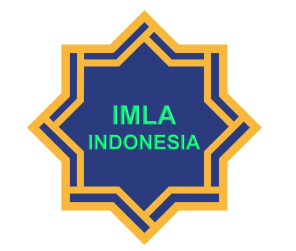Istikhdām Kitāb "Belajar Bahasa Arab Secara Tepat" fī Ta‘līm al-Lughah al-‘Arabīyah lil-Ṣaff al-Thālith bi-Madrasat Binnur al-Thānawīyah al-Islāmīyah Rembang
DOI:
https://doi.org/10.21580/alsina.6.2.23365Keywords:
Arabic language teaching, educational book, learning methodologyAbstract
This study aims to describe the use of the textbook "Belajar Bahasa Arab secara Tepat" in teaching Arabic to third-grade students at Binnur High School, Sulang, Rembang, and to identify its strengths and weaknesses. Employing a qualitative descriptive field approach, the researcher collected data through observation of teaching processes, interviews with students and teachers, analysis of curriculum documents and the textbook, and a questionnaire involving 20 students. Data analysis involved reduction, presentation, and conclusion drawing. Findings indicate that the textbook supports the acquisition of language skills (reading, writing, listening, speaking) within 2-2.5 years, with a 95% student satisfaction rate. Its strengths include a systematic structure and practical exercises, while limitations include reliance on teacher explanations and limited alignment (20%) with the national curriculum (KMA 183/2019). The findings suggest the textbook’s potential for effective Arabic instruction in pesantren contexts, though adaptations are needed to enhance alignment and support diverse learners. Further research is recommended to test generalizability across other institutions.
Downloads
References
Abdurochman. “Strategi Pembelajaran Kosakata Bahasa Arab Bagi Non Arab.” An-Nabighoh 19 (2017).
Al-Samān, Muḥammad ʿAlī. Al-Tawjīh Fī Tadrīs Al-Lughah Al-ʿArabīyah. Cairo: Dār al-Maʿārif, 1983.
Alhawary, Mohammad T. Teaching Arabic as a Foreign Language: Techniques for Developing Language Skills and Grammar. London: Routledge, 2023. https://doi.org/10.4324/9781315686677.
Azaz, Mahmoud. “Integrating the Genre-Based Approach into Teaching Writing in Arabic As a Foreign Language.” Journal of the National Council of Less Commonly Taught Languages 9 (2016): 31–60. https://www.ncolctl.org/files/jncolctl-vol-19/Integrating-the-Genre-Based-Approach.pdf.
Brown, H. Douglas. Principles of Language Learning and Teaching. 5th ed. New York: Pearson Education, 2007.
Burhan, Ali et al. “Peranan Pembelajaran Mata Kuliah Bahasa Arab Pada Kemampuan Menulis Berbahasa Arab Bagi Mahasiswa Program Studi Pendidikan Bahasa Arab (PBA) Angkatan 2009 Jurusan Tarbiyah STAIN Pekalongan” 10 (2013): 130–48.
Calafato, Raees. “Charting the Motivation, Self-Efficacy Beliefs, Language Learning Strategies, and Achievement of Multilingual University Students Learning Arabic as a Foreign Language.” Asian-Pacific Journal of Second and Foreign Language Education 8, no. 1 (2023): 20. https://doi.org/10.1186/s40862-023-00194-5.
Cohen, Louis et al. Research Methods in Education. London: Routledge, 2017. https://doi.org/10.4324/9781315456539.
Creswell, John W., and Cheryl N. Poth. Qualitative Inquiry & Research Design: Choosing Among Five Approaches. Thousand Oaks, CA: SAGE Publications, Inc., 2018.
Dajani, Basma Ahmad Sedki. “Teaching Arabic Language: Towards a New Beginning That Stimulates Creativity.” Procedia - Social and Behavioral Sciences 192 (2015): 758–63. https://doi.org/10.1016/j.sbspro.2015.06.086.
Dörnyei, Zoltan. The Psychology of Second Language Acquisition. Oxford: Oxford University Press, 2009.
Dörnyei, Zoltán, and Ema Ushioda. Teaching and Researching: Motivation. London: Routledge, 2013. https://doi.org/10.4324/9781315833750.
Hertsch, Max Florian, and Altan Alperen. “Innovative and Organized Approaches for Foreign Language Teaching in Turkey.” Procedia - Social and Behavioral Sciences 47, no. 1 (2012): 679–83. https://doi.org/10.1016/j.sbspro.2012.06.716.
Ibrāhīm, ʿAbd al-ʿAlīm. Al-Muwajjih al-Fannī li-Mudarris al-Lughah al-ʿArabīyah. Cairo: Dār al-Maʿārif, 1968.
Irawan, Bambang. “Developing Arabic Teaching Materials Based on Local Culture to Enhance Reading Skills And Its Implications on Self-Regulated Learning.” IJIE International Journal of Islamic Education 2, no. 2 (2023): 57–72. https://doi.org/10.35719/ijie.v2i2.1895.
Khoii, R., and S. Sharififar. “Memorization versus Semantic Mapping in L2 Vocabulary Acquisition.” ELT Journal 67, no. 2 (2013): 199–209. https://doi.org/10.1093/elt/ccs101.
Kustina, Kiki et al. “The Intercultural Aspect of Teaching Arabic as a Foreign Language in Indonesia.” Mantiqu Tayr: Journal of Arabic Language 4, no. 1 (2024): 279–93. https://doi.org/10.25217/mantiqutayr.v4i1.4086.
Letmiros, Letmiros. “Arabic: Why Indonesian Have to Learn It?” International Review of Humanities Studies 4, no. 2 (2019): 610–24. https://doi.org/10.7454/irhs.v4i2.166.
McDonough, Jo et al. Materials and Methods in ELT: A Teacher’s Guide. 3rd ed. Hoboken: Wiley-Blackwell, 2013.
Miles, Matthew B. et al. Qualitative Data Analysis: A Methods Sourcebook. 3rd ed. California: SAGE Publications, Inc, 2014.
Niswah, Fiki Khoerun et al. “Athar Istīʿāb al-Mufradāt wa-al-Qawāʿid ʿalá Kafā’at al-Kitābah al-Imlā’īyah li-al-Talāmīdh fī al-Faṣl al-Thāmin bi-Madrasat Al-Waṭanīyah al-Thānawīyah al-Islāmīyah Kebumen.” Alsina : Journal of Arabic Studies 3, no. 2 (2021): 181–200. https://doi.org/10.21580/alsina.3.2.4214.
Richards, Jack C., and Theodore S. Rodgers. Approaches and Methods in Language Teaching. Cambridge: Cambridge University Press, 2014. https://doi.org/10.1017/9781009024532.
Ryding, Karin C. Teaching and Learning Arabic as a Foreign Language: A Guide for Teachers. Washington D.C.: Georgetown University Press, 2013.
Tomlinson, Brian. “Materials Development for Language Learning and Teaching.” Language Teaching 45, no. 2 (February 24, 2012): 143–79. https://doi.org/10.1017/S0261444811000528.
Yūnus, Fatḥī ʿAlī. Al-Marjiʿ fī Taʿlīm al-Lughah al-ʿArabīyah lil-Ajānib. Cairo: Maktabat al-Wahbah, 2003.
ʿUmar, Aḥmad Anwar. Al-Kitāb al-Madrasī: Taʾlīfuhu wa-Ikhrājuhu al-Ṭibāʿī. Riyadh: Dār al-Marīkh, 1980.
Downloads
Published
How to Cite
Issue
Section
License
Copyright (c) 2024 Alsina : Journal of Arabic Studies

This work is licensed under a Creative Commons Attribution-NonCommercial-ShareAlike 4.0 International License.
Copyright
The copyright of the received article shall be assigned to the publisher of the journal. The intended copyright includes the right to publish the article in various forms (including reprints). The journal maintains the publishing rights to published articles. Authors are allowed to use their articles for any legal purposes deemed necessary without written permission from the journal, but with an acknowledgment to this journal of initial publication.
Licensing
In order for Alsina: Journal of Arabic Studies to publish and distribute research articles, the editors need publishing rights (transferred from author to publisher). This agreement relates to the transfer/publishing copyright license to Alsina: Journal of Arabic Studies but the authors still have significant rights to use and share their published articles.
Alsina: Journal of Arabic Studies supports the need for writers to share, disseminate and maximize the impact of their research and their rights on any database. As a journal article writer, you have the right to various uses of your articles, including that by the institution or company where you work. Copyright can be used without the need for special permission. Authors who publish articles in the Alsina: Journal of Arabic Studies have broad rights to use their work for teaching and scientific purposes without requesting permission, including:
- Use by the author for lectures, presentations, or conferences, with distribution of copies to participants;
- Distribution to colleagues for research use;
- Use in compilations of the author's subsequent work;
- inclusion in a thesis or dissertation;
- Reuse of sections or excerpts from articles in other works (with full acknowledgment of the final article);
- Preparation of derivative works (other than commercial purposes) (with full acknowledgment of the final article);
- Voluntary posting on open websites operated by authors’ or writers' agencies for scientific purposes
When submitting a manuscript, authors do so on the understanding that if accepted for publication, the copyright for publishing (publishing right) of the article shall be assigned/transferred to Alsina: Journal of Arabic Studies.
Authors whose articles are accepted for publication will receive confirmation via email and sent a Copyright Transfer Agreement.

 Accreditation
Accreditation 
 In Collaboration with
In Collaboration with 

 Visitors
Visitors  Article Template
Article Template





